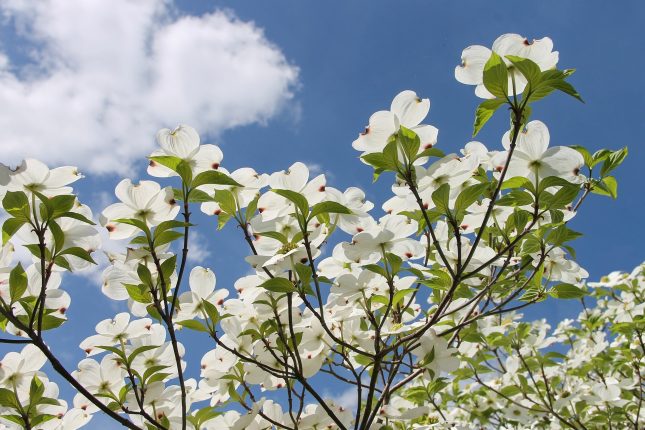Our state flower, the Cornus florida!
For immediate release ‐ April 29, 2021
Contact: Jessica Wackes, 919.707.9850. Images available upon request
By Chris Goforth, Head of Citizen Science, and Jess Wackes, PR & Marketing Coordinator
It’s that time in nature when the flowering dogwoods (Cornus florida) are blooming! These beauties will pop up more and more as summer approaches, though flowering dogwoods are lovely any time of the year.

What are signs of full spring? When dogwood trees are full of blossoms, of course!
Petals, but not really…
The flowering dogwood is one of the most iconic Southern trees (and our state flower) because they’re one of the first to bloom early spring. However, are you looking at the right “flower” when observing these sprightly white dazzlers?
The white parts of the dogwood “flower” are actually bracts, or modified leaves, that protect the flowers developing inside. These bracts eventually peel back, revealing the true flowers they conceal: small, yellow-green blossoms seen in clusters at the bract’s center! The flowers typically begin to bloom before the leaves appear and most will have dropped from the tree before the last leaves have unrolled.
The part they play
In fall and early winter, the trees sport bright red berry-like fruits that are important winter food sources for many local birds and mammals. Despite their importance, the production of these clusters has been threatened in recent years by the fungal pathogen dogwood anthracnose.
Because the disease quickly spreads through the wood and can damage or kill the tree, it’s of great concern in western North Carolina, other parts of the Eastern US, and the Pacific Northwest.
You’ll find flowering dogwoods in the understory of the forest of Prairie Ridge Ecostation along our Forest Trail. Their springy branches make them a favorite to birds and squirrels enjoying the lush landscape at Prairie Ridge. Take a moment in the sunshine to observe the creatures native to our state in this unique prairie nestled right outside of downtown Raleigh!
For more information about our upcoming activities, seasonal news and ground-breaking research, follow @NaturalSciences on Instagram, Twitter and Facebook. Join the conversation with #visitNCMNS.

